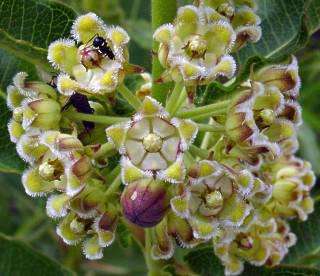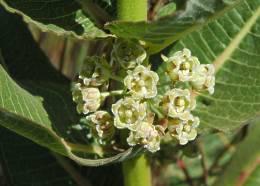Xysmalobium undulatum
Xysmalobium undulatum (L.) Aiton f. var. undulatum
Family: Apocynaceae
Common names: milk bush, milkwort, uzura, wild cotton, wave-leaved xysmalobium (Eng.); bitterhout, bitterwortel, bitterhoutwortel, melkbos (Afr.); leshokoa, poho-tehla (Southern Sotho); iyeza elimhlophe, nwachaba, iShongwane (Xhosa); iShongwane, iShongwe, iShinga (Zulu)
Introduction
The wave-leaved xysmalobium is a well-known feature of the verges of most of the highways in the grassland biome during November and December. Initially the round clusters of flowers attract the attention - these are soon replaced by the equally grand, inflated fruits — a truly magnificent, magical, medicinal plant!

Description
Description
iShongwane is a robust geophytic herb, 0.5-2.0 m tall. It sprouts annually from a rootstock in spring and dies back in winter. The hairy leaves are large, 80-270 x 10-75 mm, almost stalkless, ± heart-shaped, prominently veined and with a rounded base. Many-flowered, stalked inflorescences develop in the axils of the leaves. The lobes of the flowers are erect, with the tips recurved. The recurved tips are covered in short stout white hairs which are diagnostic for the species.
Flowers are cream-green to yellow and are produced from October to December.

The fruit are large, 90-100 x 35-50 mm, an inflated follicle, covered with long curly hairs.
; 
All parts of the plant exude a milky sap when damaged.
Conservation Status
Status
Although extensively harvested for its medicinal use in South Africa, this taxon is listed as Least Concern (LC) in the latest assessment (Raimondo et al. in prep.).
Distribution and habitat
Distribution description
Xysmalobium undulatum is widely distributed in mainly the eastern parts of southern Africa (found in all the provinces of South Africa and in Namibia, Botswana, Lesotho and Swaziland). Its range extends to tropical Africa as far north as Kenya. It grows at altitudes of 84-2000 m above sea level in areas with higher rainfall, in open grassland or moist grassland, particularly in wetlands and seepage areas.
Derivation of name and historical aspects
History
The genus Xysmalobium consists of about 40 species, all endemic to Africa. About 24 species are found in southern Africa, all of them mainly associated with grassland.
The Greek word xysma meaning lint (bandage, covering or plaster) and lobion meaning pod, allude to the fruit which is covered with hairs. The epithet undulatum (Latin) refers to the wavy margins of the leaves.

Two varieties, the typical and var. ensifolium are distinguished. The latter is distinguished by the generally thinner leaves rarely with waving (undulate) margins and flowers that are much smaller. Var. ensifolium is also restricted to the drier, western areas at altitudes of 1000-1300 m and flowers slightly later (December to April).
Ecology
Ecology
The wide distribution, successful establishment and subsequent colonization of a wide range of habitats, especially disturbed areas, demonstrate the tolerance of this species to a wide range of edaphic and physiographic factors. Plants often grow in vlei areas, in moist grassland, and in seasonally wet areas, river and streambanks. They may be found in open veld, on mountain slopes, on stream banks, and along roadsides. Specimens have been collected from sandy loam, loam, clay, black turf and marshy soils, and have been associated with limestone, dolomite and granite.
Plants attract an array of insects that feed on the plant itself or the flowers. This may attract larger predatory insects, butterflies and even birds to a garden.
Uses
Use
A tuft of hairs is attached to the seeds. These "parachutes" help to disperse the seed when the ripe fruit burst open. These fibres are collected and used to stuff pillows.
The sap from the plants is extremely bitter. The powdered root is sprinkled on skins and hides to prevent dogs from gnawing them whilst they are left in the sun to dry. The milky sap of this and various other species is also rubbed over eggs that need to be hatched to deter dogs from stealing them. The latex contains a large amount of gum but has not yet been commercially exploited.
The powdered root is used to treat wounds and abscesses. It is widely used in Africa and elsewhere, and sold in Europe as an anti-diarrhoeal under the name Uzura. In traditional medicine it is also used to treat headaches. Dry powdered root and extracts of the root are apparently an excellent remedy for painful menstrual cramps and have an antispasmodic action.
The root has been widely used for treating indigestion and malaria and other fever, including typhoid. An infusion is taken by mouth for malaria causing profuse perspiration.
The plant is used as a protective charm to divert storms, and make dogs keen hunters.
The Zulu grind up the stem in water as an emetic in poisoning.
The Xhosa take an infusion or a decoction of the root for colic and abdominal troubles and use the powdered root as a snuff to relieve headache. They also apparently take wine in which grated root has been soaked as a tonic, and apply the latex to festering wounds as a prophylactic against the development of maggots. They also apply fomentations with the root to the chest for bad colds.
The Mpondo use a root decoction or the powdered root alone as a dysentery remedy.
The Nama take the root as a stomach carminative and diarrhoea remedy.
The Tswana chew a piece of the root as an antidote to the effects of food poisoning.
A cold-water extract of the root has been used in the treatment of lumpy skin disease (knoppiessiekte) in cattle.
Uzara came onto the pharmaceutical market in 1911 as a "new intestinal sedative" (antidiarrhoicum). In 1927 another preparation made from the root was put on the market under the name dysmenural. This was a tablet containing amongst others the active compound uzaron. More recently Uzara has been recommended for diarrhoea and dysentery, after-birth cramps, and as a tonic to the cardiovascular system.
The southern Sotho use the young leaves as spinach or green vegetable. Preparations of the root will act as an excellent bitter tonic.

Growing Xysmalobium undulatum
Grow
Xysmalobium undulatum is generally not cultivated, but is utilised from the wild. Because of the deep-seated rootstock it is usually extremely difficult to transplant mature plants successfully. The easiest ways to propagate plants is to grow them from seed. Sow the seed at the start of the growing season in a well-drained sandy medium. Seeds germinate easily and grow well in well-drained soil with optimum germination when sown ±1 cm deep. Preferably make use of black plastic containers that have ample space to contain the long roots. This will also help to protect the roots when transplanting to the final position in the garden.
Plants are relatively quick-growing, but may only flower after a number of years. They are long-lived, need full sun and plenty of water but are sensitive to frost which causes them to die back during the cold season.
These plants may make an interesting addition to any indigenous garden in the areas where this taxon occurs naturally. Both the flowers and developing fruit are very attractive but quite short-lived. Unfortunately this species has never been widely cultivated primarily because of the amount of latex that it produces and because it dies back annually in winter. It is also parasitized by a number of insects.
References
- Brandwijk, M.G. 1927. The chemistry of the root of Xysmalobium undulatum R.Br. (South African National Herbarium No. 3299). Transactions of the Royal Society of South Africa 14(4): 353-365.
- Germishuizen, G. & Fabian, A. 1997. Wildflowers of northern South Africa. Fernwood Press.
- Langley, R.W. 1980. Taxonomic studies in the Asclepiadeae with particular reference to Xysmalobium R.Br. in southern Africa. M.Sc. thesis (unpubl.), Univeristy of Natal, Pietermaritzburg.
- Leistner, O.A. (ed.). 2000. Seed plants of southern Africa : families and genera. Strelitzia 10. National Botanical Institute, Pretoria.
- Nicholas, A. 1999. A taxonomic reassessment of the subtribe Asclepiadiinae (Asclepiadaceae) in southern Africa. PhD thesis. University of Durban Westville, South Africa.
- Pole Evans, I.B. 1926. Xysmalobium undulatum. The Flowering Plants of South Africa 6: t. 215.
- Pooley, E. 2003. Mountain Flowers. A field guide to the flora of the Drakensberg and Lesotho. Natal Flora Publications Trust, Durban.
- Pooley, E. 2005. A field guide to wild flowers of KwaZulu-Natal and the Eastern Region. Natal Flora Publication Trust, Durban.
- Raimondo, D., Von Staden, L., Foden, W., Victor, J.E., Helme, N.A., Turner, R.C., Kamundi, D.A. & Manyama, P.A. (eds). In prep. Interim Red Data List. South African National Biodiversity Institute, Pretoria. (www.sanbi.org).
- Smith, C.A. 1966. Common names of South African plants. Memoirs of the Botanical Survey of South Africa No. 35.
- Van Wyk, A.E. & Malan, S.J. 1997. Field guide the the wild flowers of the Highveld. Struik Publishers, Cape Town.
- Van Wyk, B.-E. & Gericke, N. 2000. People's plants: a guide to useful plants of southern Africa. Briza Publications, Pretoria.
- Van Wyk, B.-E., Van Oudtshoorn, B. & Gericke, N. 1997. Medicinal plants of South Africa. Briza Publications, Pretoria.
- Watt, J.M. 1935. The uses and actions of Xysmalobium undulatum R.Br. South African Journal of Medicine and Science, vol. I (1, 2) Sept.
- Watt, J.M. & Breyer-Brandwijk, M.G. 1962. Medicinal and poisonous plants of southern and eastern Africa. Livingstone, Edinburgh and London.
Credits
Stoffel Petrus (Pieter) Bester
National Herbarium, Pretoria
December 2009
Plant Attributes:
Plant Type: Moss, Perennial
SA Distribution: Eastern Cape, Free State, Gauteng, KwaZulu-Natal, Limpopo, Mpumalanga, Northern Cape, Western Cape
Soil type: Sandy, Clay, Loam
Flowering season: Spring, Early Summer
PH:
Flower colour: Green, Cream, Yellow
Aspect: Full Sun
Gardening skill: Challenging
Special Features:
Horticultural zones










Rate this article
Article well written and informative
Rate this plant
Is this an interesting plant?
Login to add your Comment
Back to topNot registered yet? Click here to register.